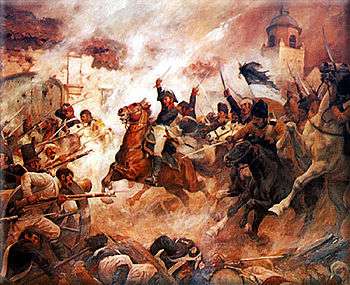Battle of Rancagua
| Battle of Rancagua | |||||||
|---|---|---|---|---|---|---|---|
| Part of the Chilean War of Independence | |||||||
 Bernardo O'Higgins' charge by Pedro Subercaseaux | |||||||
| |||||||
| Belligerents | |||||||
|
|
| ||||||
| Commanders and leaders | |||||||
|
|
| ||||||
| Strength | |||||||
|
2,000 6 cannons |
2,200 18 cannons | ||||||
| Casualties and losses | |||||||
| 600 killed, 400 wounded, 888 captured | 111 killed, 113 wounded | ||||||
The Battle of Rancagua also known as the Disaster of Rancagua occurred on October 1, 1814, to October 2, 1814, when the Spanish Army under the command of Mariano Osorio defeated the rebel Chilean forces led by Bernardo O’Higgins. This put an end to the Chilean Patria Vieja and it was the beginning of the Spanish Reconquista of South America.[1]
Background
When Spain heard about the Patriot revolt in Chile, they sent an army of Spanish soldiers and royalists to defeat the rebellion. When O'Higgins heard about the besieged army in Rancagua, he went with his army of 1,000 patriots, to reinforce Juan Carrera's army in Rancagua. Outnumbered and with barely enough supplies, O'Higgins did not retreat and sealed the destiny of his army.
The Battle
The battle occurred on the morning of October 1, 1814, outside the town of Rancagua. The Chilean forces had occupied the town prior to this confrontation, ultimately were surrounded by Osorio’s forces who advanced towards the town.[2] The reason for occupying the town was its strategic importance in the defense of the Chilean capital, Santiago. The battle was fierce and the Spanish had an elite force of soldiers known as “Talaveras” who were veterans from the Napoleonic Wars in Europe. As the fighting continued onward to the evening, the Spanish forces decided to set fire to the town.[3] With casualties growing, the Chilean forces requested reinforcements from the capital city of Santiago, which was 87 Kilometers north of Rancagua.[4] Ultimately the request failed and forced the Chilean army to disperse and flee to the countryside and wilderness. After the defeat, the Spanish went into Santiago and crushed the Chilean Government and instituted their brutal Reconquista of Chile.
Aftermath
After the Battle of Rancagua, the Spanish captured Santiago within a few days and this marked the beginning of the Reconquista of South America. This battle became a stain in Chile's national memory as it was a time when the nation was lost and the people were hopeless that their struggle for independence was in vain. The people fled elsewhere in South America as refugees to escape the violence the Spanish would have given to the rebels.[5]
See also
References
- ↑ Collier, Simon (2004). A History of Chile, 1808-2002 Second Edition. Cambridge: Cambridge University Press. pp. 35–37. ISBN 0-521-82749-3.
- ↑ Ossa, Juan (2014). Armies, politics and revolution Chile, 1808-1826. Liverpool: Liverool University Press. p. 52. ISBN 978-1-78138-132-8.
- ↑ Ossa, Juan (2014). Armies, politics and revolution Chile, 1808, 1826. Liverpool: Liverpool University Press. p. 53.
- ↑ Clissold, Stephen (1969). Bernardo O'Higgins and the Independence of Chile. Washington, New York: Frederick A. Praeger, Publishers. pp. 129–131.
- ↑ Kinsbruner, Jay (1968). Bernardo O'Higgins. New York: Twayne Publishers Inc. p. 84.